Life during COVID-19: Staying connected when we're apart
Families in Australia Survey report
July 2020
Megan Carroll, Kelly Hand, Mikayla Budinski, Jennifer Baxter
Download Research report
Overview
May 2020: the first wave of the coronavirus pandemic was upon us, and we surveyed 7,306 people about how they had been affected. Every state and territory was in some form of lockdown. The restrictions differed, but what everyone had in common was a degree of forced isolation.
We have a special interest in families and what helps them thrive, so a number our questions focussed on how people stayed connected, particularly when physically separated. In reply, they gave us information, ideas, advice and inspiration. This is what they shared.
Key messages
-
Many people (37%) found it difficult to connect with family members living elsewhere, though almost everyone (93%) made the effort.
-
The families who kept up the best connection often lived close by or made creative use of technology (see 'Creative connections').
-
Many older people struggled with video calls and the like, and many still depended on face-to-face visits for contact and support. (See 'Tech tips' below for ideas on how to help.)
Zooming all four families together once a week instead of our Shabbat dinner… It's chaotic but fun!
Female, 66, lives in a major city, couple-only household
Connecting through the lockdown
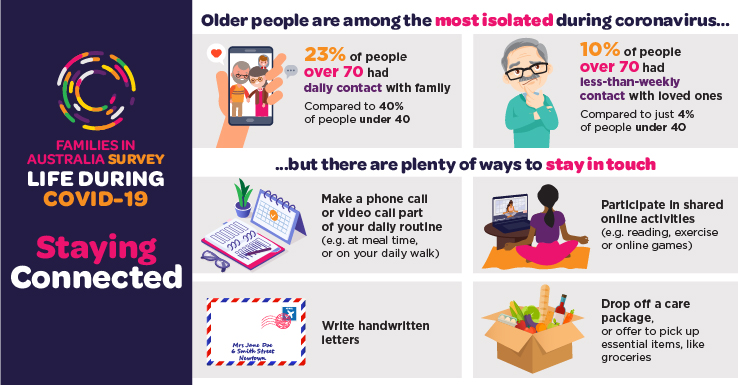
During the May lockdown, people who lived with others felt just as connected (33%) or more connected (51%) to the people in their household. However when it came to the family they didn't live with, only a third (31%) felt more connected, while 37% felt less connected.
Table 1: Connection to family through the lockdown
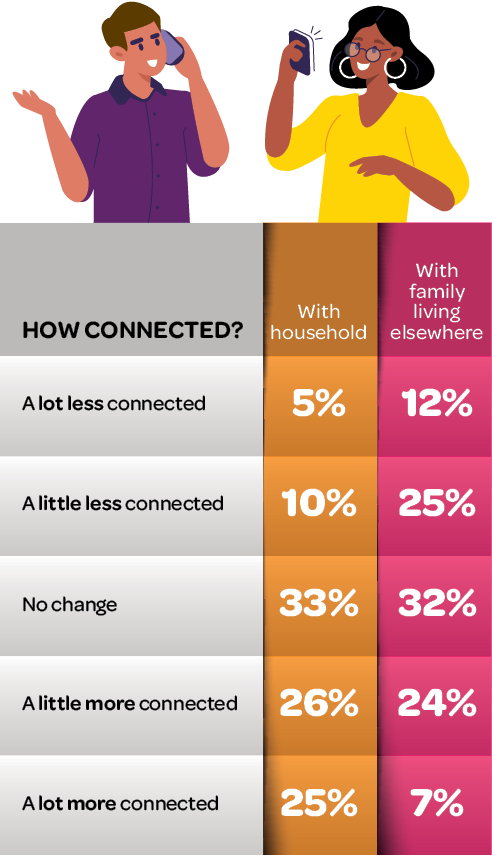
Still, practically everyone made an effort to stay connected. The great majority (93%) contacted family living elsewhere at least once a week, and 31% had some form of contact every day.
Most people talked to family living elsewhere at least as often as before, and a good proportion (44%) talked to them more than before.
My parents & brothers live interstate so we might talk more at present but we can't physically be with them (which we normally would have in this time).
Female, 43, lives in a major city, household with children
Prior to this pandemic, I spent two hours a day commuting. I now can use that time to call, Zoom or message friends and family overseas, as well as spending more time with my partner and with the person with whom we share our property (a disabled friend).
Female, 59, lives in a regional area, multiple-adult household, no children
Have not been able to visit elderly mother who lives alone. Have phoned more often for longer duration & sent mail by post each week to provide positive surprises in the mailbox. Have sent flowers & gifts especially for Mothers' Day. Mother has rung me more often & is feeling isolated & unable to attend exercise class & other social connections - very difficult for someone who lives alone. Usually very motivated to cook, bake, etc. I cannot visit due to risk to her. My GP said not to risk it.
Female, 50, lives in a major city, household with children
| Frequency | % |
|---|---|
Note: Excludes N/A (1.16 %). | |
| A lot more often | 11 |
| A little more often | 33 |
| About the same | 43 |
| A little less often | 8 |
| A lot less often | 4 |
People over 70, however, were more likely than others (53% vs 42%) to report no change in their contact with family living elsewhere.
My family and friends mostly live interstate and intrastate and I have always kept in touch by regular phone calls as a way to maintain and grow our relationships. I have continued to do what I have always done.
Female, 67, lives in a major city, single-adult household
Older and more isolated
Older people had less contact with family. Around 40% of people aged under 40 had daily contact with family living elsewhere, compared with only 23% of those over 70. And people over 70 were twice as likely as people under 40 to have less-than-weekly contact (10% vs 4%).
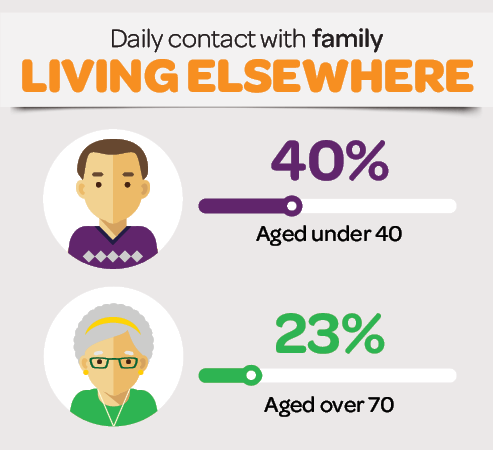
| Frequency of contact | Age <40 % | Age 70+ % |
|---|---|---|
| Every day | 40 | 24 |
| Several times a week | 43 | 43 |
| About once a week | 12 | 23 |
| Less than once a week | 4 | 10 |
| Not at all | <1 | <1 |
In general being a little more concerned particularly with overseas relatives & corresponding a lot more with them through the WhatsApp family group one of my nieces organised.
Female, 74, lives in a regional area, couple-only household
For those who connected at least once a week, the most common means were text and voice calls.
People under 40 were more likely than older people, particularly people over 70 (58% vs 33%), to regularly connect using video calls; almost the same number of older people regularly wrote letters (30%) as made video calls. Conversely, only 19% of people under 40 regularly wrote letters.
Figure 1: Regular connection with family living elsewhere, method, under 40 vs 70+

Note: Regular connection, meaning at least once a week.
We have not had our granddaughter in our home or to stay over as she did do about once a month, prior to COVID. We have Skyped and phoned and emailed and a couple of chats over the fence! We have also posted letters, cards & drawings.
Female, 66, lives in a regional area, couple-only household
We have used mail to distant relatives a lot, 90 years + people, to send and have things to talk about. Care packs for Easter, Mothers' Day and birthdays as well as other parcels. We have relied on post. Unfortunate that mail has been so slow interstate.
Male, 57, lives in a regional area, household with children
IRL (in real life)
Some people, particularly older people, were still able to see family in person. In two-thirds of cases, the in-person visit had the purpose of giving and receiving support.
Figure 2: Seeing family living elsewhere in person, at least once a week

Of course in many cases, the reason for the in-person contact was simply to foster connection.
We still had special celebrations for birthdays etc. - by dropping gifts out the front of people's houses and calling them up.
Female, 30, lives in a regional area, couple-only household
Walking with a family member not living in the family home.
Female, 60, lives in a major city, household with children
And there were also cases where the in-person contact was made possible by family members living next door to each other, or on shared properties.
My neighbours on our rural property include my son and his family and on the other side my parents. This has enabled us to talk over the fence etc as often as we like.
Female, 52, lives in a regional area, multiple-adult household, no children
Creative connections: Fun and games
Many people told us they were doing things with other people online. Around 60% of the time it was simply talking/texting, but 25% of people reported doing some other kind of activity, beyond talk and text.
Figure 3: Most common activities of people who connected online
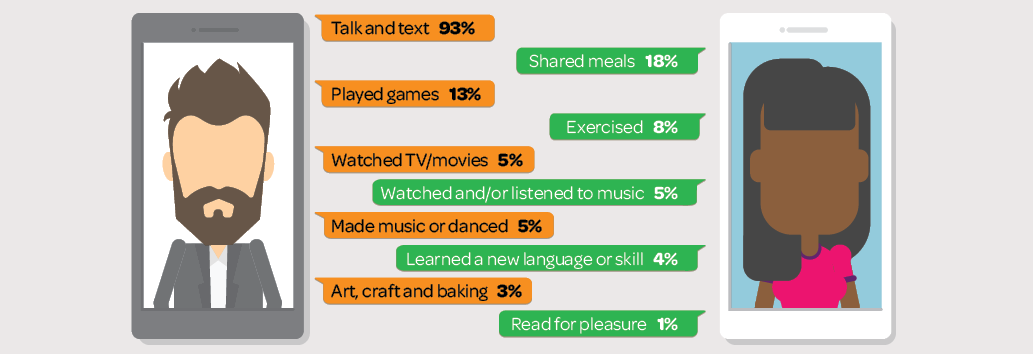
Note: % of people doing online activities (n=4,257)
Tried this? Creative ways to stay in touch
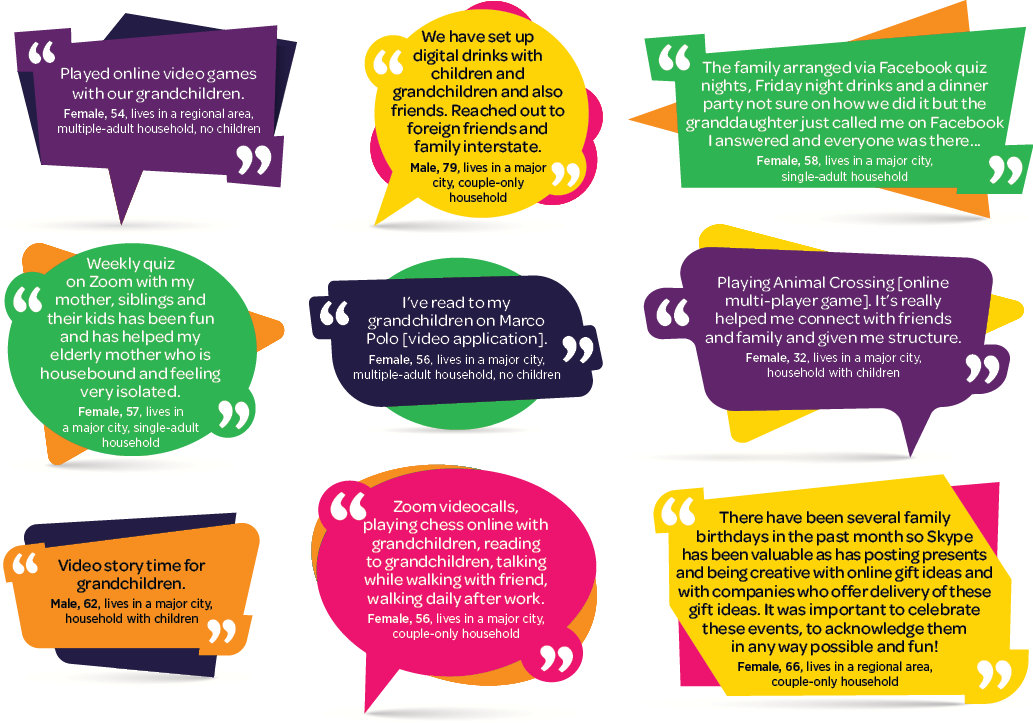
Tech tips for families and older people
Researchers from the Shaping Connections program, a collaboration between RMIT and the University of the Third Age, found that 'many seniors who struggled with digital devices felt they lacked support. In particular, they said their own families often displayed a "can't be bothered explaining" attitude.' It's up to younger family members to turn that attitude around.
Shaping Connections found that many seniors see their grandchildren as willing to help without judgement. But many seniors are reluctant to ask for help with technology. So if you have an older relative who is struggling, a good place to start could be to encourage your child to take the initiative and offer them assistance. The downside is that your child may only focus on fixing a specific problem, whereas the best kind of help is where the older person is taught a new skill.
Technology permitting, regular online contact between older people and their family members is something our survey families told us helped keep them happy and connected.
If using technology is a challenge, this article by researchers from the University of Waterloo has some great tips about how to support older people who want to use technology. There are also a number of quality, often free, in-person and online services that can help:
- Be Connected is a government website with 'free, easy-to-use lessons… that provide step-by-step help to get older Australians started with technology'.
- Local libraries and regional library networks often provide excellent technology-for-seniors training. Look them up on your local library website.
Once you have made a connection using technology, read the tips from this recent research by Western Sydney University's Baby Lab about how to have a successful video call with the grandkids.
About the survey
Life during COVID-19 was the first survey in the Families in Australia Survey (AIFS' flagship survey series). The first wave ran from May 1 to June 9 2020, when all states were in various stages of lockdown. There were 7,306 respondents. A second wave is planned for November 2020.
Contact
For more information, email [email protected].
Media releases
Credits
Editor: Michael Day
Graphic design: Lisa Carroll
Hand, K., Carroll, M., Budinski, M. & Baxter, J. (2020). Life during COVID-19: Staying connected when we're apart. (Families in Australia Survey report). Melbourne: Australian Institute of Family Studies.